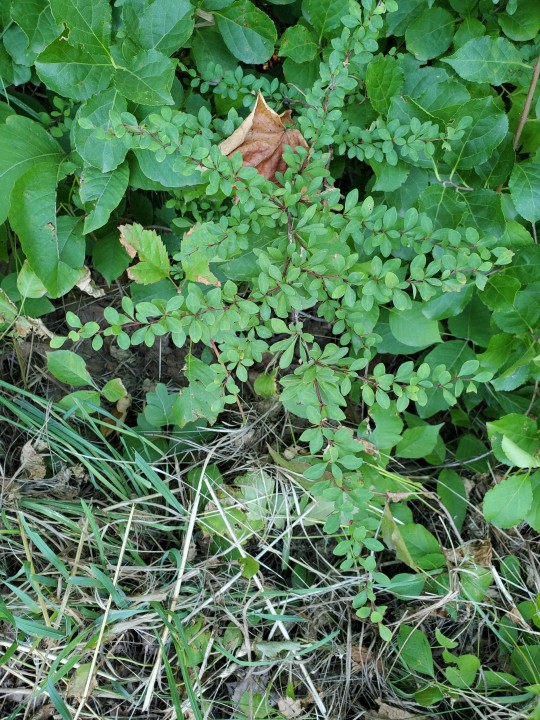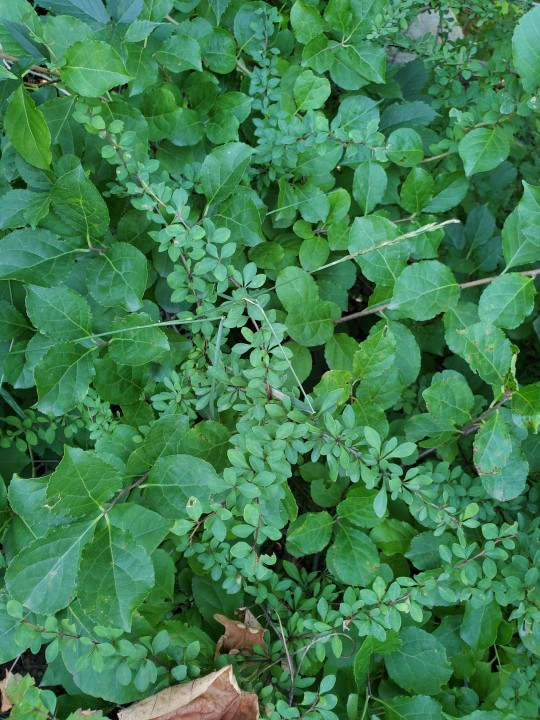#Berberis thunbergii
Text
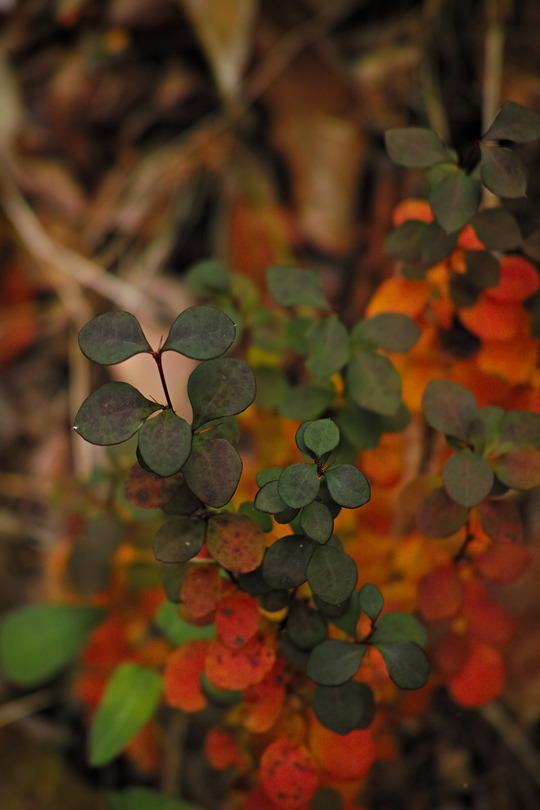
目木[Megi]
Berberis thunbergii
目[Me] : Eye
木[-gi|Ki|Boku] : Tree
It was believed that eye diseases could be cured by washing with the juice of a decoction of its roots and stems, hence the name. It is also called 小蘗[Shōbaku], which is also read as megi. Its height is about less than two meters. Trees that do not grow very large, like this one, are called 灌木[Kanboku] or 低木[Teiboku]. 灌 means grow in clusters, 低 means low.
It produces small five-petaled light yellow flowers in spring and prolate spheroidal red fruits similar to those of 枸杞[Kuko](Lycium chinense) in autumn.
It also has another alias, 小鳥不止[Kotoritomarazu], which means the tree that small birds do not perch, because of the sharp spines growing from the base of its leaves. 蟻通し[Aridooshi](Damnacanthus indicus var. indicus) has the same alias because it has spines similar to Megi. There is an approximate species called 蛇不登[Hebinoborazu](Berberis sieboldii,) which means the tree that snakes do not climb.
16 notes
·
View notes
Text
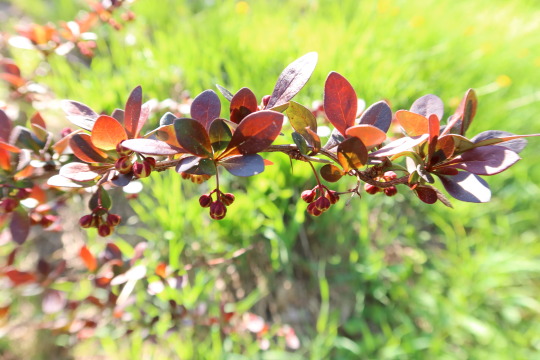
Berberis thunbergii — Japanese barberry
14 notes
·
View notes
Text
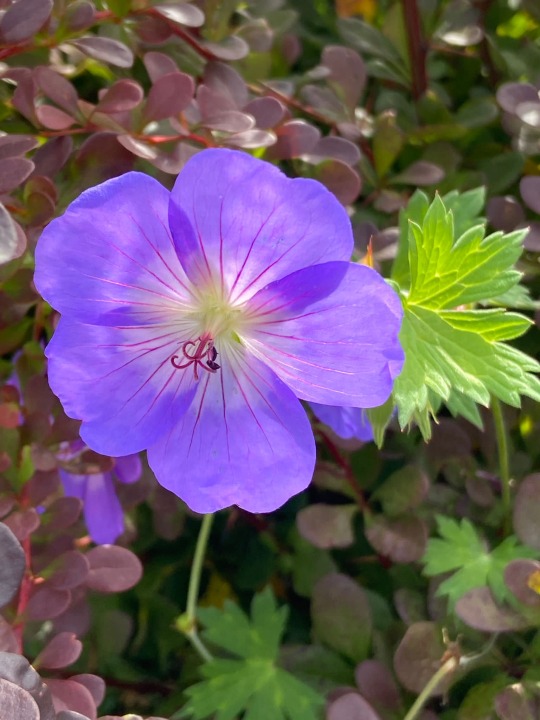



Plant of the Day
Thursday 15 September 2022
The vigorous and floriferous herbaceous Geranium 'Gerwat' (geranium Rozanne, hardy geranium, cranesbill) is scrambling through the deciduous shrub Berberis thunbergii f. atropurpurea (purple Japanese barberry). What a great combination of dependable plants.
Jill Raggett
#Geranium#hardygeranium#cranesbill#Berberis#purpleJapanesebarberry#Japanesebarberry#purpleflowers#purplefoliage#deciduousshrub#herbaceousperennial#plants#writtledesign#gardens#horticulture#garden#kirkwall#scotland
87 notes
·
View notes
Text
I’m currently working in a garden that is almost only boxwoods (Buxus sempervirens) and Annabelle smooth hydrangeas (Hydrangea arborescens ‘Annabelle’). It’s pretty but it’s so curated that it feels kind of oppressive. Luckily, the client inherited the landscape and when I mentioned it to her she seemed relieved that she had permission to not like the look. We’re leaving the structure in place but we’re adding in tons of pollinator plants with lots of color to cheer it up. It’s very 90s gardening magazine right now and she wants something more fun.
I’m adding in Sweet Joe Pye (Eutrochium purpureum), sweetspire (Itea virginica), creeping oregon-grape holly (Mahonia repens), coral bells (Heuchera), and false sunflower (Heliopsis helianthoides). They can all take dappled shade in our area and will hopefully liven up the color scheme with magenta and yellow.
Most of what I’m planting also provides great fall color and winter interest so that seasons actually mean something in this evergreen garden. For that purpose I’m also going to plop in about a million spring bulbs, they’re not native but at least they’ll look pretty and provide something for early pollinators.
Elsewhere, I’m going to plant purple poppy mallow (Callirhoe involucrata), blue indigo (Baptisia australis), rosemallow (Hibiscus moscheutos), snowberry (Symphoricarpos albus), aromatic aster (Symphyotrichum oblongifolium) and goldenrod (Solidago missouriensis) in sunny spots. In those areas the only plants are roses (Rosa), spirea (Spirea japonica), barberries (Berberis thunbergii), and some evergreens (Taxus, Pinus, Picea). The roses are alright, I personally hate spirea and barberries but they’re so established I don’t think we’ll be able to do much about them.
It’s a beautiful location and a very sweet client so it’s a joy to work in. I might have to post some pictures of the finished product.
1 note
·
View note
Text
Japanese Barberry Invasive Plant
Japanese barberry (Berberis thunbergii) is a popular ornamental plant used in landscapes across the east coast of the United States. Native to Japan, the plant was introduced into the United States in 1875 and has since become one of the most highly invasive plants in temperate regions worldwide. The Japanese barberry invasive plant’s ability to grow under various conditions makes controlling the effects difficult.
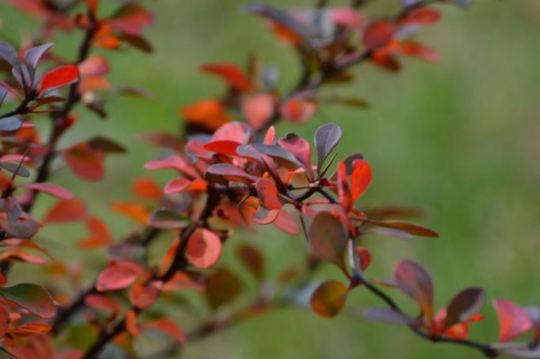
What the Japanese Barberry Invasive Plant Looks Like
Size: The shrub is compact and dense, rarely exceeding 4 feet in height. The brown, spiny branches will also touch the ground.
Flowers: The flowers are pale yellow and often have around six petals each.
Fruit: Berries are glossy bright red to orange-red. Each berry is also around 1/4 to just under 1/2 inch long.
Leaves: Japanese barberry leaves are distinctly spoon or spatula-shaped with smooth edges. The leaves typically have a thick, leathery, and bright green appearance but can have some red or purple coloring and are 1 inch or less long.
Stem: The exterior of the stem is grooved and rusty brown with single spines, while the inner bark is bright yellow.
Damage Caused by Japanese Barberry
One of the reasons the Japanese barberry invasive plant causes damage is that the shrub is a host for several human diseases, including Lyme disease. Bites from the black-legged or deer tick (Ixodes scapularis) transmit the disease, making Lyme disease a common vector-borne illness in the United States. In humans, early symptoms of this disease include rash, fever, headaches, and tiredness. If untreated, symptoms may also include joint pains, severe headaches, or heart palpitations.
The microclimate of Japanese barberry is favored by ticks, because it protects them from temperature and humidity fluctuations as opposed to relatively taller and thinner native vegetation. In addition, the relatively low stature of barberry plants provides plenty of opportunities for ticks to come in contact with humans.
Why Japanese Barberry is Highly Invasive
One of the reasons Japanese barberry has been highly invasive is due to a high tolerance for shade. The plant can tolerate high or low amounts of sunlight and even dry conditions. This has made Japanese barberry particularly troublesome in urban or suburban areas where large trees provide valuable shade and create environments where the invasive plant thrives. In addition, the plant has few natural predators, as deer prefer to feed on other plants. The result is that the plant is able to spread quickly and thrive in various environments.
Pennsylvania Bans Japanese Barberry
The Japanese barberry invasive plant has caused so much harm to landscapes and people that the Pennsylvania Department of Agriculture designated the plant as a noxious weed. As a result, Japanese barberry cannot be legally sold or cultivated in the state. The ban was implemented in October 2021 and penalties are rolling out to nurseries or other landscaping businesses that sell the plant. As a result, property owners should not buy Japanese barberry for their landscapes and should contact a plant health care expert to have the invasive plant removed from their property if necessary.
Controlling & Removing Japanese Barberry
If you have Japanese barberry on your property, you can work with plant health care professionals to remove it. Be aware that the seed of this species also remains viable in the soil for up to 10 years. As a result, removal must be followed by at least two or three years of follow-up monitoring and control. In addition, seeds germinate in early spring and grow quickly. The seeds can be challenging to remove via mechanical means because the seeds often grow in dense stands in which individual plants are inaccessible.
Sprouting from stolons (horizontal shoots) or roots is another problem that may occur after removal efforts have been completed. Work with a professional to carefully monitor and control these sprouts.
Contact Burkholder PHC for Invasive Plant Treatment & Removal
The Japanese barberry invasive plant poses risks to human health. As a result, we recommend a professional evaluation to help remove the plant and control any adverse effects. Our evaluation is free, and proper treatments can restore your landscape’s health. Contact Burkholder PHC today for a free consultation.
Blog is originally published at: https://www.burkholderphc.com/japanese-barberry-invasive-plant/
It is republished with the permission from the author.
0 notes
Photo

Berberis thunbergii "Orange Rocket" (Japanese Barberrry) [OC]
0 notes
Text
Berbére-japonês – Berberis thunbergii
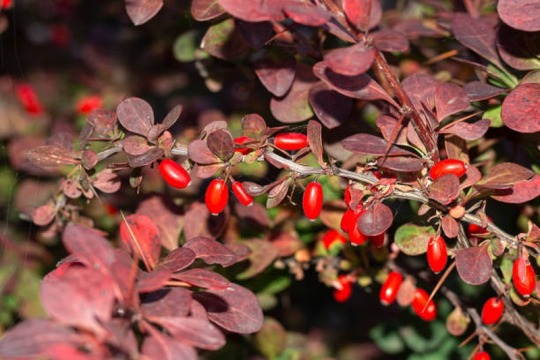
Nome Científico: Berberis thunbergii
Nomes Populares: Bérbere-japonês, Berbere-japonês, Uva-espim-do-japão
Família: Berberidaceae
Categoria: Arbustos, Bonsai, Cercas Vivas
Origem: Ásia, Japão
Altura: 0.4 a 1.80 metros
Luminosidade: Meia Sombra, Sol Pleno
Ciclo de Vida: Perene
Sobre a Berbére-japonês
O Berbére-japonês é um arbusto lenhoso e de pequeno porte que pode alcançar até 1,5 metros de altura.
O seu tamanho mínimo é de apenas um metro. Os seus ramos são ramificados, desenvolvendo-se em zigue zague, sendo muito finos.
O seu córtex é castanho e de madeira amarela. Nesses locais é que começam a nascer os espinhos pontiagudos que tornaram a espécie não mais utilizada na ornamentação em geral.
Há muitas variedades de berbére-japones. Um das mais famosas é a atropurpurea, de ocorrência natural e que apresenta folhas avermelhadas que se tornam alaranjadas no outono.
Outras importantes cultivares incluem: “Aurea”, “Bagatelle”, “Bonanza Gold”, “Crimson Pygmy”, ‘Kobold’, “Rose Glow” e “Variegata”, entre outras.
As diferenças entres as cultivares geralmente estão relacionadas com a cor das folhas, que pode variar desde o amarelo limão até púrpura intenso, incluindo formas variegadas.
Há também plantas mais ou menos compactas e de portes diferentes.
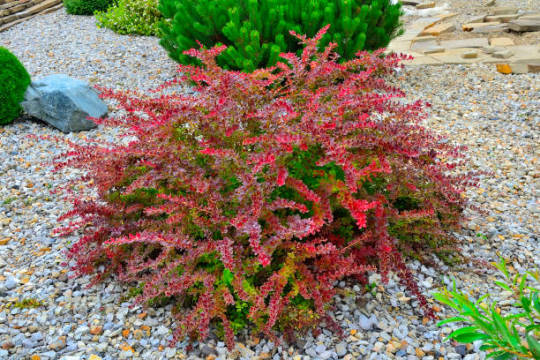
Modo de plantação do Berbére-japonês
O Berbére-japonês pode ser plantado de forma isolada, ainda que fique bem em maciços e renques.
É uma ótima opção para a formação das famosas cercas vivas, muito úteis para jardins grandes e abertos. Tais cercas vivas podem ser formais e informais, já que a espécie é bastante tolerante as podas.
Por causa dos seus espinhos, as cervas vivas formadas podem ser muito eficientes contra determinados invasores.
Por isso, a espécie é ultimamente usada como um fator de proteção aos jardins do que simplesmente uma planta para decorar.
Adornando pátios e varandas, a espécie também pode ser cultivada, sem maiores problemas, em vasos ou jardineiras.
Também é muito apropriado usar a espécie para formar lindos Bonsais.
Deve ser cultivado sob sol pleno ou meia-sombra, em solo fértil, drenável, enriquecido com matéria orgânica e irrigado regularmente.
Aprecia o frio de climas temperados e subtropicais.
Deve ser manuseado com luvas grossas, devidos aos espinhos. Apresenta crescimento lento, e por conseguinte baixa manutenção.
É tolerante à poluição e estiagem, porém não resiste a encharcamentos por períodos prolongados.
Multiplica-se por sementes, estaca e divisão da ramagem enraizada.
https://youtu.be/T_uONV0NJzw
Flores
É na Primavera que a espécie começa a dar flores. A floração do arbusto é considerada de beleza exótica, até mesmo por causa da tonalidade em que elas podem desenvolver-se.
As flores são do tipo umbela, com pétalas pequenas que nascem na cor amarela na sua totalidade. Mesmo assim, as sépalas podem coloração amarelo avermelhadas.
Por causa desta grande mistura de tons que as flores da espécie possuem, as abelhas acabam sendo atraídas, iniciando um longo processo de polinização.
Read the full article
0 notes
Text
Rose Glow Barberry

Berberis thunbergii f. atropurprprea
0 notes
Text
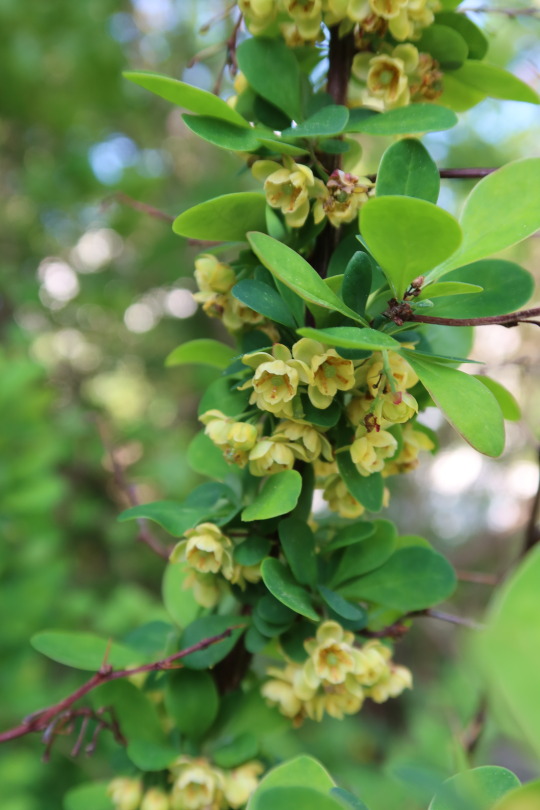
Berberis thunbergii — Japanese barberry
8 notes
·
View notes
Text
How To Improve Clay Soil?
Introduction
Soil is the foundation of any successful garden. Whether you have clay soil or sandy soil, there are ways to improve it so that it can be more fertile and supportive for your plants. Clay soil tends to be heavy and dense, which means it doesn’t drain well when it rains—not ideal for gardening! But with some smart planning and practical steps, you can turn your yard into a lush paradise with minimal effort. Let’s explore how to improve clay soil in your yard:
Top-dress the lawn.
The best time to top-dress your lawn is late winter or early spring before the grass grows too long. Top-dressing is a quick, easy way to improve soil structure and add nutrients. It also helps prevent weeds from taking over your lawn by keeping them from gaining a foothold in the soil.
Top-dressing with compost will give you the biggest bang for your buck because it improves both soil structure and nutrient content. It also helps suppress weeds by creating more competition for available water and nutrients in the soil. Compost can be purchased at many gardening stores or you can make it yourself using manure (cow, chicken, horse) mixed with straw or sawdust (for carbon).
Break up clay in hard soil.
If you are working with hard clay, there are a number of tools that you can use to break up the soil. These include:
A spade or pickaxe
A rotary hoe
A tractor or tiller
A fork (also known as a pitchfork) and rake (also known as a garden rake) to turn over the soil so that it breaks apart more easily. Another option is to use a hoe if your yard has small pieces of soil at its base.
Avoid walking on wet clay soil.
When clay is wet, it is even heavier and more difficult to walk on than when dry.
You risk breaking your foot or ankle if you step on muddy clay soil.
It’s best not to walk on clay soil at all when it’s wet because of its high water content, which makes it heavy and slick.
Apply gypsum to break down clay soil.
Gypsum is a mineral that’s mined and used as a soil amendment to improve soil structure. It helps break down clay soil, which allows for better water drainage and aeration. Gypsum also acts as a natural fertilizer, so it’s great for plants recovering from drought or in sandy soil conditions.
In addition to improving the quality of your garden, gypsum can help you save money by making your own compost instead of buying bagged compost from the store!
Plant ground covers in poorly drained areas.
Plant ground covers. Clay soil can be a challenge to work with, but one of the best ways to improve clay soil is by adding ground cover plants. Ground covers can be used to cover up bare areas, areas where grass won’t grow and also help reduce erosion in poorly drained areas. These plants require little maintenance and can form a mat that will prevent water from running off quickly. You’ll want to avoid using groundcovers that may cause problems for lawn mowers such as spireas (Spiraea), goldenrods (Solidago), wild bergamots (Monarda fistulosa) and Japanese barberry (Berberis thunbergii).
Plant shallow-rooted plants in clay soil.
Plant shallow-rooted plants in clay soil.
Trees and shrubs: These need more space than most other plants, so plant them farther apart than you would in sandy or loamy soils. The roots will grow outward from the trunk, so choose a spot where they can spread out without being crowded by other plants.
Vines: Because vines are not large enough to compete with the larger trees and bushes, they can be used as ground covers or understory plants to soften hard surfaces in clay soil areas such as driveways or patios. They also work well on fences and trellises where they will help provide privacy while adding interest to your landscape design ideas for your home exterior decorating project!
Reduce foot traffic on lawns.
It’s important to reduce foot traffic on lawns.
Mow high, with sharp blades. Higher grass will shade the soil below, reducing evaporation and improving water retention.
Mow often, but not too short. Don’t cut off more than 1/3 of the height of your grass at any one time; this can damage roots and make them vulnerable to disease and pests. If you’re using a mulching mower, don’t let it fill up with clippings before emptying—this could encourage pests to breed in the debris pile!
Avoid walking or running on wet lawns when possible—you’ll compact the soil beneath your feet and leave tracks that will cause runoff if it rains or sprinkles later in the day (which is likely). If you must walk through wet grass after it rains or sprinkles: wear shoes made for running (not just sneakers) so that they don’t sink into muddy ground; avoid stepping directly onto plants since this may damage roots; stay away from drains where standing water collects because those areas are especially prone to erosion once saturated by rainfall/sprinklings!
Using a zero-turn mower allows users full control over speed while cutting their turf due their ability maneuverability along contours at faster speeds reducing downtime between cuts saving time overall because less stopping means less idling which reduces greenhouse gas emissions associated with exhaust fumes created by older equipment models such as push reel mowers etcetera…
Dig a garden bed that is raised above the surrounding ground level.
Dig a garden bed that is raised above the surrounding ground level. Raising your garden bed will improve drainage, aeration, soil temperature, soil moisture and fertility by creating an underground reservoir of water that can be accessed by plants during periods of drought.
Amend clay soil with organic matter to loosen compacted clay particles so they can absorb water more easily and hold onto it longer. Organic matter should make up half the volume of your amended mixture (by volume).
Add sand or gravel to help with drainage if necessary—but don’t add too much because this can lead to nutrient runoff into nearby bodies of water when you irrigate your garden!
Want to grow things in your yard? Improve that clay soil!
Clay soil is a poor-quality soil that contains tiny particles of rock, or silt. It can be hard to work with and difficult to plant in. clay soil tends to have a very high water content, which means it drains very slowly. In order for plants and grasses to grow well in clay, you will need to improve the texture of the soil so water can penetrate more easily into its depths.
Conclusion
You’ve got your hands full with gardening. Don’t let clay soil be one of them.
Clay soil
,
Garden Clean up Adelaide
,
Lawn Mowing Adelaide
,
mowing services adelaide
0 notes
Photo
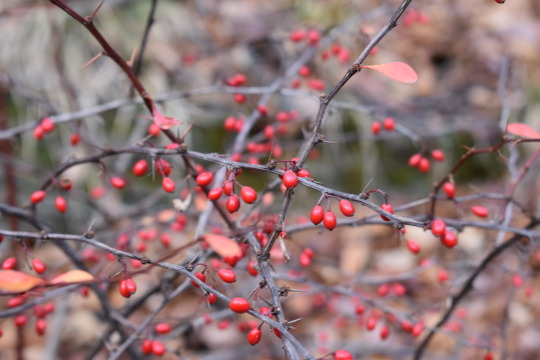
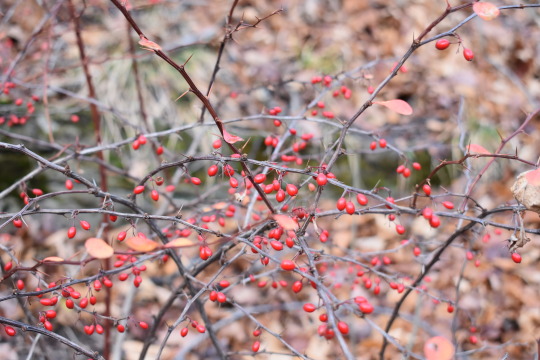
Japanese Barberry
Berberis thunbergii
Berberidaceae Family
Photographs taken on December 5, 2020, at the Niagara Glen Nature Centre, Niagara Falls, Canada.
#wildflowers of southern ontario#Japanese Barberry#barberry#berry#berries#fruit#Berberis thunbergii#Berberis#Berberidaceae#niagara#Niagara Glen Nature Centre#niagara falls#ontario#canada
7 notes
·
View notes
Photo
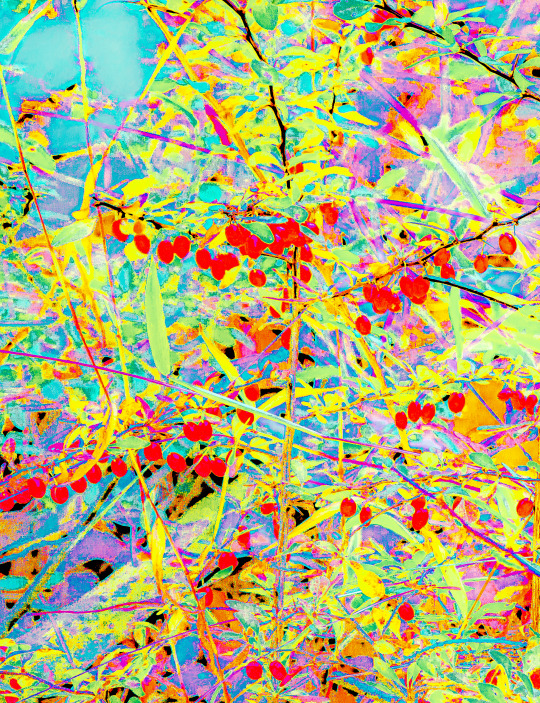
11 notes
·
View notes
Text
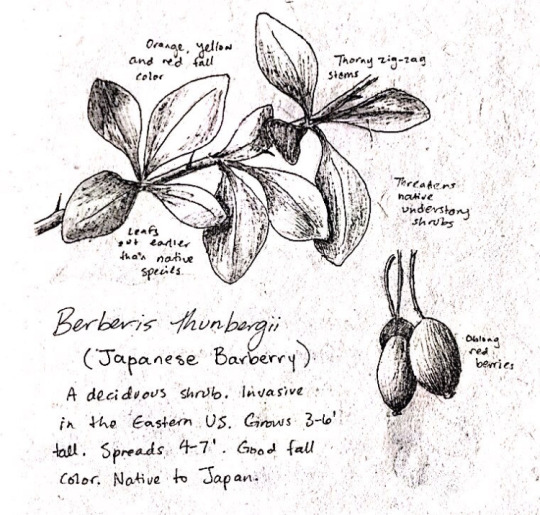
berberis thunbergii
#my art#botanical illustration#pen#black and white#horticulture#botany#scientific illustration#plants#flowers#gardening#field guide#berberis thunbergii#japanese barberry
18 notes
·
View notes
